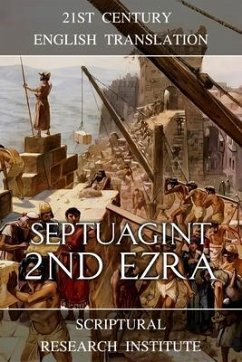Both the Greek translations of 1¿¿ and 2n¿ Ezra, and the Hebrew translation of Ezra (2n¿ Ezra), contain relics of an Aramaic source-text, unfortunately, the Aramaic Book of Ezra-Nehemiah is lost. The difference in the surviving Aramaic words within the Greek 1¿¿ Ezra, and Hebrew Ezra (Greek 2n¿ Ezra), it appears that the two versions of Ezra already existed in the Aramaic versions. The differences between 2n¿ Ezra and Masoretic Ezra are minimal, and could be accounted for as scribal notes, and the redaction of Simon the Zealot, who added the name Yahweh extensively to the ancient texts when he translated them into Hebrew. 1¿¿ Ezra, the less spiritual of the two versions of the Septuagint's Ezra, clearly dates to the Persian era, as it treats the Judahite Lord of the Temple in Jerusalem as another version of Ahura Mazda, the Zoroastrian God. Several Zoroastrian titles of Ahura Mazda are applied to the Judahite Lord, including King of Truth, and King of the Sky. Letters from the Persian Kings Cyrus II, Artaxerxes I, and Darius II, as included in the book, all of which were closely associated with Zoroastrianism, yet, referred to the Judahite Lord using titles generally associated with Ahura Mazda. In the Greek 1¿¿ Ezra and 2n¿ Ezra, as well as the Hebrew Ezra, the temple is described as being a Zoroastrian fire-temple, containing an eternal fire, which Nehemiah even referred to as burning naphtha, like the other fire-temples across the Persian Empire.
As the books of Ezra includes a Letter from Cyrus dated to the first year of his rule over Babylon, this letter would date to 539 BC, however, the rest of the kings aren't always easy to distinguish from each other, as the Persian Empire had three kings named Darius, and four named Artaxerxes. The books of Ezra also describe several different groups of Judahites returning from Babylon, and in 2n¿ Ezra and Masoretic Ezra the stories repeat with different details, as once there must have been separate Aramaic books of Ezra and Nehemiah that contained different details. The first group of Judahites to return from Babylon, were sent by Cyrus II after he conquered Babylon in 539 BC. They were led by Zerubabbel ben Shealtiel, and the priest Jesus ben Jehozadak, although Sheshbazzar was listed as the 'chief of Judah.' Sheshbazzar is a Persian name that translates as 'fire-worshiper,' and so he could not have been an Israelite, and was likely the Persian military governor dispatched to Jerusalem to secure it for the Persian Empire. After they defeated the Babylonians, most regions of the Babylonian Empire attempted to become independent states, and Cyrus II spend the nine years after Babylon fell consolidating his empire, before dying in battle, without ever sending an expedition into Egypt, which had been part of the Babylonian Empire, and which he had theoretically conquered.
Cyrus II's heir, Cambyses II did conquer Egypt, Nubia, and Cyrenaica, however, was assassinated before he could launch his planned invasion of Carthage. The books of Ezra all include a letter sent by Tattannu, the governor of Syria and Phoenicia, which inquired about the temple that Zerubbabel and the returned Judahites were building in Jerusalem, along with a replying letter from King Darius confirming that Cyrus authorized the temple's construction, and Darius further ordering the governor of Syria and Phoenicia to assist. This letter is sent during the era of Zerubbabel, who had been sent by Cyrus II, and therefore the king in question had to be Darius I, who ruled between 522 and 486. The beginning of his rule was only 17 years after King Cyrus II had sent Zerubbabel to Jerusalem, while Darius II would not assume the throne for another century.
As the books of Ezra includes a Letter from Cyrus dated to the first year of his rule over Babylon, this letter would date to 539 BC, however, the rest of the kings aren't always easy to distinguish from each other, as the Persian Empire had three kings named Darius, and four named Artaxerxes. The books of Ezra also describe several different groups of Judahites returning from Babylon, and in 2n¿ Ezra and Masoretic Ezra the stories repeat with different details, as once there must have been separate Aramaic books of Ezra and Nehemiah that contained different details. The first group of Judahites to return from Babylon, were sent by Cyrus II after he conquered Babylon in 539 BC. They were led by Zerubabbel ben Shealtiel, and the priest Jesus ben Jehozadak, although Sheshbazzar was listed as the 'chief of Judah.' Sheshbazzar is a Persian name that translates as 'fire-worshiper,' and so he could not have been an Israelite, and was likely the Persian military governor dispatched to Jerusalem to secure it for the Persian Empire. After they defeated the Babylonians, most regions of the Babylonian Empire attempted to become independent states, and Cyrus II spend the nine years after Babylon fell consolidating his empire, before dying in battle, without ever sending an expedition into Egypt, which had been part of the Babylonian Empire, and which he had theoretically conquered.
Cyrus II's heir, Cambyses II did conquer Egypt, Nubia, and Cyrenaica, however, was assassinated before he could launch his planned invasion of Carthage. The books of Ezra all include a letter sent by Tattannu, the governor of Syria and Phoenicia, which inquired about the temple that Zerubbabel and the returned Judahites were building in Jerusalem, along with a replying letter from King Darius confirming that Cyrus authorized the temple's construction, and Darius further ordering the governor of Syria and Phoenicia to assist. This letter is sent during the era of Zerubbabel, who had been sent by Cyrus II, and therefore the king in question had to be Darius I, who ruled between 522 and 486. The beginning of his rule was only 17 years after King Cyrus II had sent Zerubbabel to Jerusalem, while Darius II would not assume the throne for another century.
Dieser Download kann aus rechtlichen Gründen nur mit Rechnungsadresse in A, D ausgeliefert werden.









